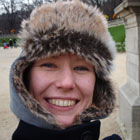Her name is Joy and I photographed her outside one of the many African churches in south-east London. I had just finished photographing a mosque on the same bland industrial estate when I found the blue wall, then spotted Joy dancing in the church with her children. I thought: “That’s a portrait I’ve got to get,” and asked if she’d come outside and have her photograph taken.
Her dress speaks to her sense of cultural pride. She’s in her element, in church, in a place where she can showcase her Nigerian clothes. When you put that across in the divisive time in which we’re living, it paints a positive story about her identity as a Londoner, especially when you consider the wider context. Six countries in Europe have banned the burqa (16 worldwide) and Quebec has banned all religious symbols, but London has created spaces for people to celebrate their cultural heritage, and that’s special.
Joy’s church is Christ’s Chosen Church of God. It’s one of several black-majority churches in streets where old warehouses are being used for Sunday worship. The services contrast with the mundane exteriors: worshipping God among the Nigerian community is a very celebratory experience. Outfits such as Joy’s are commonplace, and a good amount of the service is spent dancing and singing. I think that’s why so few people I approached for this project said no to being photographed – they are happy to do it when they feel good about themselves.
I photographed Joy in August 2019, towards the end of a three-year project I called Sunday Best, which celebrates London’s religious diversity through portraits and stories of Londoners dressed for worship. My first idea was to photograph African churches in my area of south London, because the black teens in their Sunday best look so different from the negative stereotypes about hoodie culture. The project was shaped and expanded by events that unfolded thereafter.
In June 2016, there was the Brexit vote, then the terrorist attacks in London in June 2017, which came just after I had a baby. I started to feel very pessimistic about bringing a child up in Britain, but after the Grenfell Tower fire I read all these tweets from people from other countries saying how much they admired the way the British – of all religions and races – pulled together in times of crisis. The lens through which other countries saw us seemed much more empathetic than how we view ourselves, and that made me want to reinforce a more positive vision of what it means to British.
I chose to look at multiculturalism through religion because it’s so attached to national and cultural identity, and I sought out places of worship that served particular communities rather than particular denominations. The response I got came as a surprise, people saying: “We are British, and part of being British is being able to celebrate who we are. You don’t get this anywhere else in the world.” Such experiences built a celebratory and optimistic foundation for the project, amid a sombre national mood.
As I went into the various places of worship, I became very aware of my own cultural misconceptions. I’m not religious, and I think that people like me sometimes think of religion in terms of ill-informed assumptions and problems. Take Islam. There are very narrow representations of Muslims in the media, but it’s a religion of 1.8 billion people. It can’t be represented by a few stereotypes. There’s a culture of fear based on a simple lack of understanding and knowledge that then breeds separatism and mistrust. But what religion brings to people’s lives in terms of a sense of belonging, companionship and community far outweighs the negatives. The religious people I spoke with talked about prayer and how much it helps with mental health.
The religious diversity of London – and other cities such as Leicester, Manchester or Birmingham – should be celebrated. There are many different ways of telling stories of Britishness, but it’s the divisive ones that are predominating at the moment. Instead of submitting to negative depictions, I want to use photography to show the best of who we are.
• Sunday Best by Katie Waggett is published by Hoxton Mini Press.
Katie Waggett’s CV
Born: High Wycombe, 1984.
Training: BA graphic arts and design at Leeds Metropolitan University, and MA photojournalism and documentary photography at London College of Communication.
Influences: Diane Arbus, Liz Hingley, Vanessa Winship, and my mother, Jackie Waggett, who was a painter and printmaker.
High point: ‘Every time I come back with a portrait I’m proud of.’
Low point: ‘Someone I adored died last year, and the way I found out destroyed me. I threw myself into photography, which became a kind of therapy for me. I try to hold on to the idea that a low point can also be creative.’
Top tip: ‘If you want to photograph a stranger, smile as you approach. That sense of trust needs to be there from the start. It’s so simple, but many people who try to do what I do get turned down because they forget.’











